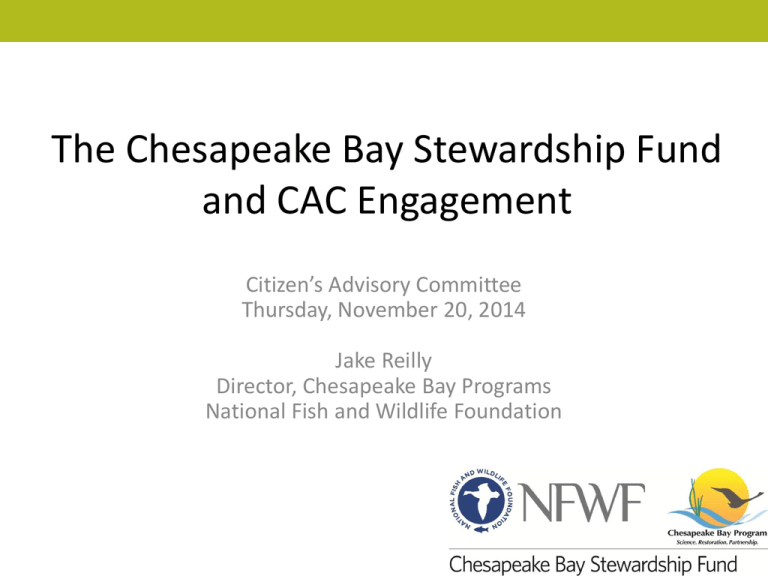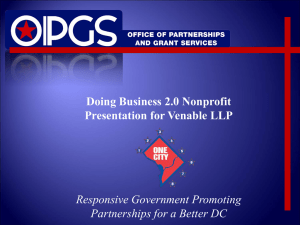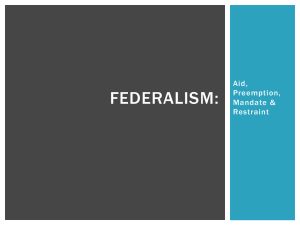jake_reilly_cac_11-20-14
advertisement

The Chesapeake Bay Stewardship Fund and CAC Engagement Citizen’s Advisory Committee Thursday, November 20, 2014 Jake Reilly Director, Chesapeake Bay Programs National Fish and Wildlife Foundation What’s being funded and where? What’s working? How can CAC be more engaged in CBSF grants programs? NFWF’s Chesapeake Bay Business Plan Business Plan Strategies 1. Focus on High Priority Targeted Watersheds Using a science-based approach, NFWF has identified 17 watersheds where investments will result in measurable increases in species populations, and improvements in water quality and local stream health. 2. Support Innovation on Cross Cutting Issues Invest in innovative methods and new technologies that hold the promise to drive down costs, expand the effectiveness of restoration practices and accelerate the pace of recovery. 3. Advance Local Government Green Infrastructure Solutions Over 1800 units of local government have authority over decisions that will determine the future of the Chesapeake Bay. NFWF helps local governments restore their rivers and streams while meeting the challenges posed by Chesapeake restoration. CBSF Program Delivery Cycle CBSF “Technical Capacity” Grants Programs Assess Conservation Needs and Capacity Ag Networking Forum Receive Feedback through Networking and Information Sharing Build Local Capacity for Restoration Small Watershed Grants Monitor and Assess Project Implementation NFWF Monitoring and Assessment Pilot Support On-TheGround Restoration and Conservation Efforts Innovation Grants CBSF Program Delivery Cycle CBSF “Technical Capacity” Grants Programs Assess Conservation Needs and Capacity Ag Networking Forum Receive Feedback through Networking and Information Sharing Build Local Capacity for Restoration Small Watershed Grants Monitor and Assess Project Implementation NFWF Monitoring and Assessment Pilot Support On-TheGround Restoration and Conservation Efforts Innovation Grants CBSF Implementation Grants Small Watershed Grants - Grants of $20k-$200k - 25% match requirement - State agencies are not eligible - Improve local waters that contribute to Bay health - About $3 million awarded per year to c. 30 grantees - Approx. 25-30% of proposals are funded Innovative Nutrient and Sediment Reduction Grants - Grants of $200k - $500k - 1:1 match requirement - State agencies are eligible - Innovative approaches to reduce N/P/S to the Bay - $6 - $8 million awarded per year to 1520 grantees - 15-20% of proposals are funded CBSF Implementation Grants 2014 Implementation Grant Priorities Targeted River and Watershed Restoration: Special focus on the Choptank and Nanticoke, Juniata, Shenandoah and Upper Potomac, and VA Middle Peninsula and Northern Neck Green Infrastructure in Urban Landscapes: • MS4 Communities: Integrating “green infrastructure” approaches into capital programs • Non-MS4: Assisting local governments in the demonstration and development of projects and programs that mitigate stormwater impacts • Residential and Commercial Properties: Increase adoption of green infrastructure practices on residential and commercial properties in targeted communities. Innovation on Crosscutting Issues: New technologies for stormwater management and agricultural conservation How these align with CAC priorities for implementation grant funding? CBSF Implementation Grants 2014 Grant Investments - $9.8 million in awards - $7.8 million in EPA funding - $700k in other Federal funding (USFS, NRCS, NOAA) - $1.25 million in private funding - 45 grants - INSR: $5.8 million to 18 projects - SWG: $3.9 million to 27 projects - Leveraging roughly $19 million in local match CBSF Implementation Grants Chesapeake Bay Stewardship Fund Grants $50,000,000 $40,000,000 Local Partner Match $30,000,000 Private Funding $20,000,000 Other Federal Agencies $10,000,000 U.S. Environmental Protection Agency $2000 2001 2002 2003 2004 2005 2006 2007 2008 2009 2010 2011 2012 2013 2014 CBSF Implementation Grants, Awards vs. Request $70,000,000 $60,000,000 $50,000,000 $40,000,000 Total Annual Awards $30,000,000 Total Annual Requests $20,000,000 $10,000,000 $2000 2001 2002 2003 2004 2005 2006 2007 2008 2009 2010 2011 2012 2013 2014 CBSF Program Delivery Cycle CBSF “Technical Capacity” Grants Programs Assess Conservation Needs and Capacity Ag Networking Forum Receive Feedback through Networking and Information Sharing Build Local Capacity for Restoration Small Watershed Grants Monitor and Assess Project Implementation NFWF Monitoring and Assessment Pilot Support On-TheGround Restoration and Conservation Efforts Innovation Grants History of CBSF Investment in Building Local Capacity for Restoration • Targeted at activities that precipitate local implementation efforts (via planning, design, assessment, prioritization, etc.) • Generally smaller awards and shorter term projects, focused primarily at urban stormwater management challenges • Delivered through a cadre of registered “Technical Assistance Providers” • Eligibility similar to SWG -- restricted to local governments, “small” conservation/watershed organizations, and conservation districts • Many iterations over the years, evolving recently into a competitive “technical assistance” grants program Need to refine and formalize this program to enhance the impact and strategic alignment with NFWF and partner objectives Revamped “Technical Capacity” Program Proposed Program Goals: • Deliver technical capacity to local partners for water quality and stewardship implementation projects through CBSF and other funding sources • Catalyze increased and more targeted local investment of restoration and protection project funding through strategic planning, design, assessment, and prioritization efforts • Support the establishment of long-term strategies for program delivery and implementation through program design and review, financing strategies, etc. Proposed Program Details: - Annual RFP, with staged application periods for each “sector” - Conservation districts are explicitly eligible - Awards capped at $40,000 - Projects capped at 12 months How can this program best serve CAC’s priorities? So… What’s working? • Driving new technologies in stormwater and agricultural conservation to accelerate water quality improvements at lower cost, with greater ease of use, etc. • New tools and approaches for targeting restoration investments for maximizing cost-effectiveness • Growing municipal interest in and adoption of sustainablyfinanced stormwater management programs • Cases of targeted, cross-sector restoration in critical areas • Regionalized delivery of stormwater management assistance • More robust approaches to promote behavior change amongst citizens, farms, etc. Engaging CAC in CBSF Grant Programs Ideas for consideration: • Formal role in developing implementation and technical capacity grants RFP priorities (late fall and late winter) • Formal role in reviewing grant applications in areas of CAC interest (early summer) • Opportunities to help frame content at networking and information-sharing events (ongoing) • Others?







